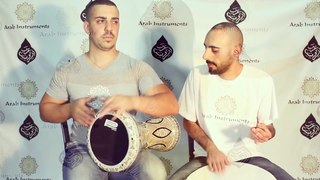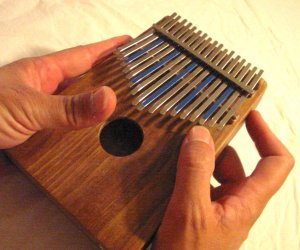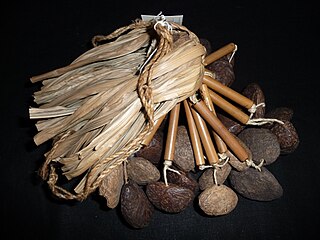
A percussion instrument is a musical instrument that is sounded by being struck or scraped by a beater including attached or enclosed beaters or rattles struck, scraped or rubbed by hand or struck against another similar instrument. The percussion family is believed to include the oldest musical instruments, following the human voice.

In Aztec mythology, Centeōtl[senˈteoːt͡ɬ] is the maize deity. Cintli[ˈsint͡ɬi] means "dried maize still on the cob" and teōtl[ˈteoːt͡ɬ] means "deity". According to the Florentine Codex, Centeotl is the son of the earth goddess, Tlazolteotl and solar deity Piltzintecuhtli, the planet Mercury. Born on the day-sign 1 Xochitl. Another myth claims him as the son of the goddess Xochiquetzal. The majority of evidence gathered on Centeotl suggests that he is usually portrayed as a young man, with yellow body colouration. Some specialists believe that Centeotl used to be the maize goddess Chicomecōātl. Centeotl was considered one of the most important deities of the Aztec era. There are many common features that are shown in depictions of Centeotl. For example, there often seems to be maize in his headdress. Another striking trait is the black line passing down his eyebrow, through his cheek and finishing at the bottom of his jaw line. These face markings are similarly and frequently used in the late post-classic depictions of the 'foliated' Maya maize god.
Hornbostel–Sachs or Sachs–Hornbostel is a system of musical instrument classification devised by Erich Moritz von Hornbostel and Curt Sachs, and first published in the Zeitschrift für Ethnologie in 1914. An English translation was published in the Galpin Society Journal in 1961. It is the most widely used system for classifying musical instruments by ethnomusicologists and organologists. The system was updated in 2011 as part of the work of the Musical Instrument Museums Online (MIMO) Project.

An idiophone is any musical instrument that creates sound primarily by the instrument as a whole vibrating—without the use of strings or membranes. It is the first of the four main divisions in the original Hornbostel–Sachs scheme of musical instrument classification. The early classification of Victor-Charles Mahillon called this group of instruments autophones. The most common are struck idiophones, or concussion idiophones, which are made to vibrate by being struck, either directly with a stick or hand or indirectly, by way of a scraping or shaking motion. Various types of bells fall into both categories. A common plucked idiophone is the Jew's harp.

Latin dance is a general label, and a term in partner dance competition jargon. It refers to types of ballroom dance and folk dance that originated in Latin America.

Zills, also zils or finger cymbals, are small metallic cymbals used in belly dancing and similar performances. They are called sājāt (صاجات) in Arabic. They are similar to Tibetan tingsha bells. In western music, several pairs of zills can be set in a frame to make a tambourine.

A lamellophone is any of a family of musical instruments. The name comes from the Latin word lamella for "small metal plate", and the Greek word φωνή phonē for "sound, voice".

A slit drum is a hollow percussion instrument. In spite of the name, it is not a true drum but an idiophone, usually carved or constructed from bamboo or wood into a box with one or more slits in the top. Most slit drums have one slit, though two and three slits occur. If the resultant tongues are different width or thicknesses, the drum will produce two different pitches. It is used throughout Africa, Southeast Asia, and Oceania. In Africa such drums, strategically situated for optimal acoustic transmission, have been used for long-distance communication.

A rattle is a type of percussion instrument which produces a sound when shaken. Rattles are described in the Hornbostel–Sachs system as Shaken Idiophones or Rattles (112.1).

The Aztec religion originated from the indigenous Aztecs of central Mexico. Like other Mesoamerican religions, it also has practices such as human sacrifice in connection with many religious festivals which are in the Aztec calendar. This polytheistic religion has many gods and goddesses; the Aztecs would often incorporate deities that were borrowed from other geographic regions and peoples into their own religious practices.
The Kepyak is a percussion instrument played by the dalang (puppeteer) of a wayang performance in Java. It is a struck idiophone consisting of several bronze or iron plates attached by strings or a single plate, which the dalang plays with a small mallet held between the toes of his right foot. It is placed on the side of the keprak, a wooden box which can also be played directly. The kepyak can also be played with a mallet (cempala), either in the hand in dance performance, or in the foot in wayang. The kepyak used in dance performances is smaller than that used in wayang. The use of the kepyak is called kepyakan.
Struck idiophones is one of the categories of idiophones that are found in the Hornbostel-Sachs system of musical instrument classification.

Kemanak is a banana-shaped idiophone used in Javanese gamelan, made of bronze. They are actually metal slit drums. It is stuck with a padded stick and then allowed to resonate. It has a specific pitch, which can be varied by covering the slit, but it is not matched to the other instruments of the gamelan. They are usually played in pairs, although they can be played in sets of four as well. They are used to accompany the bedhaya and serimpi, female court dances.

Castanets, also known as clackers or palillos, are a percussion instrument (idiophone), used in Spanish, Kalo, Moorish, Ottoman, Italian, Sephardic, Swiss, and Portuguese music. In ancient Greece and ancient Rome there was a similar instrument called crotalum. The instrument consists of a pair of concave shells joined on one edge by a string. They are held in the hand and used to produce clicks for rhythmic accents or a ripping or rattling sound consisting of a rapid series of clicks. They are traditionally made of hardwood, although fibreglass is becoming increasingly popular.

Kouxian is a general Chinese term for any variety of jaw harp. The jaw harp is a plucked idiophone in which the lamella is mounted in a small frame, and the player's open mouth serves as a resonance chamber.
Luogu is a Chinese percussion ensemble. It typically comprises several types of drum and several types of metal idiophone and wooden idiophone. Luogu music is performed in China and wherever there are populations of Chinese people.
Friction idiophones is designation 13 in the Hornbostel-Sachs system of musical instrument classification. These idiophones produce sound by being rubbed either against each other or by means of a non-sounding object. Instruments of this type are not very common; possibly the best known examples are the musical saw and the nail violin.
A blown idiophone is one of the categories of musical instruments found in the Hornbostel-Sachs system of musical instrument classification. These idiophones produce sound when stimulated by moving air. For example, the aeolsklavier features sticks while the piano chanteur features plaques.

There are several overlapping schemes for the classification of percussion instruments.












